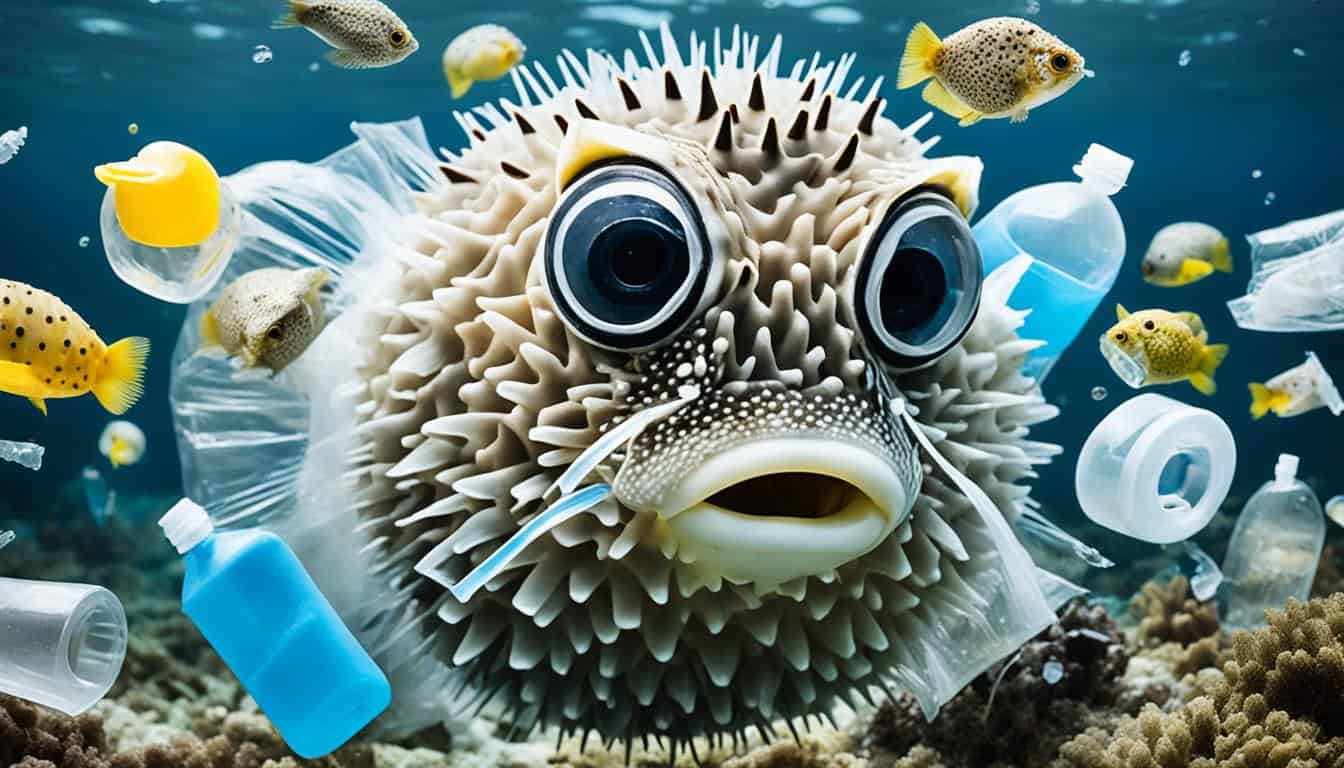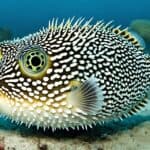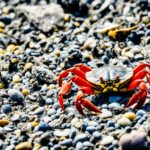Pufferfish, also known as blowfish or balloonfish, are fascinating marine animals with a unique shape and toxic skin. They seem safe, but they face many dangers. Pollution, habitat destruction, and overfishing are big threats to them. It’s important to know these threats to help protect pufferfish, as many species are in danger due to human actions and changes in the environment.
Understanding Pufferfish Species
Pufferfish show a wide range of sizes, colors, and where they live. There are over 120 types of them, mostly found in warm waters around the world. Each type has its own special traits that help them live and play important roles in their ecosystems.
Diversity of Pufferfish Species
Pufferfish come in all sizes, from the tiny pygmy puffer at an inch long to the big freshwater puffer at over two feet long. They live in many places, from coral reefs to rivers. There are both sea and freshwater pufferfish, each suited to its own home.
Unique Characteristics of Pufferfish
Pufferfish are known for their beak-like teeth, perfect for opening shells. They also can swell up to protect themselves from predators. Plus, they have a toxin that makes them not good to eat, keeping predators away.
What Threats Do Pufferfish Face?
Pufferfish face big challenges in their homes, mainly from pollution and destroying their habitats. These problems put their numbers at risk and mess with the balance of marine life. Knowing about these threats helps us see why saving pufferfish is so important.
Pollution Impact on Pufferfish
The pollution impact on pufferfish is huge. Toxic substances like plastics and chemicals harm them. Microplastics are especially bad because pufferfish can eat them, causing serious health issues. This can make it hard for them to survive.
Also, pollution makes marine life unhealthy, which means less food for pufferfish. This is a big problem for their survival.
Habitat Destruction and its Consequences
Habitat destruction makes pufferfish more at risk. Things like building along the coast and pollution can destroy where they live and find food. Coral reefs and seagrass beds are key places for pufferfish, giving them what they need to live.
When these places disappear, pufferfish face even more dangers. Saving these areas is key to keeping pufferfish safe and the ocean healthy.
| Threat Type | Description | Impact on Pufferfish |
|---|---|---|
| Pollution | Chemicals and plastics enter pufferfish habitats | Health complications and reduced survival |
| Habitat Destruction | Coral reefs and seagrass beds decline | Loss of breeding and feeding grounds |
Pufferfish Predators
Learning about pufferfish and their predators helps us understand marine ecosystems better. Sharks are a big threat to pufferfish, but they have learned to eat them safely. This shows how survival and adaptation work in the ocean.
Role of Predator Dynamics
Predators are key to pufferfish survival. They show how healthy marine environments are. By controlling pufferfish numbers, predators affect their behavior and how they adapt. These interactions help keep marine life diverse.
Defense Mechanisms of Pufferfish
Pufferfish have amazing ways to defend against predators. When threatened, they puff up to look bigger and scarier. They also have a toxin called tetrodotoxin that is deadly. This keeps predators away, helping them survive in tough places.
| Defense Mechanism | Description | Effectiveness Against Predators |
|---|---|---|
| Inflation | Pufferfish rapidly ingest water to increase their size. | Increases size and deters smaller predators. |
| Toxicity | Presence of tetrodotoxin, a potent neurotoxin. | Highly effective against larger predators like sharks. |
| Cryptic Coloration | Ability to blend into surroundings. | Helps avoid detection by visual predators. |
Pufferfish use these defenses to protect themselves and help the ecosystem. Learning about these strategies shows us how complex marine life is and the relationships within it.
Human Activities Affecting Pufferfish
Human actions are a big threat to pufferfish. Things like overfishing and building along the coast hurt their numbers. It’s important to know how these actions affect pufferfish to help protect them.
Overfishing and Bycatch Issues
Overfishing is a big worry for pufferfish. They are caught for the aquarium trade or to eat as fugu. This leads to a big drop in their numbers.
Bycatch, or catching them accidentally, makes things worse. Fishing gear meant for other fish often catches pufferfish too. This makes them more vulnerable and harms the ocean.
Impact of Coastal Development
Building along the coast hurts pufferfish a lot. These projects bring pollution and change the ocean in bad ways. This messes up the home pufferfish need to live and breed.

| Human Activity | Impact on Pufferfish |
|---|---|
| Overfishing | Population decline due to targeted fishing practices |
| Bycatch | Accidental catches that contribute to overall mortality |
| Coastal Development | Habitat loss and pollution affecting breeding grounds |
Pufferfish Conservation Status
The conservation status of pufferfish shows the big challenges they face. Human actions are harming their homes, making conservation efforts more critical. The International Union for Conservation of Nature (IUCN) has pointed out several species that need help right away.
Species Classified as Vulnerable
The Longspine Porcupinefish and White-spotted Puffer are species classified as vulnerable. They are losing numbers because of destroyed habitats and pollution. We must act fast to protect these species for their future.
Endangered Pufferfish Species
The Humpback Puffer is now an endangered pufferfish species. This happened because of too much fishing and harming the environment. Saving these endangered species is key to keeping our oceans diverse. Creating safe areas for them can really help them survive.
The Role of Ecosystems in Pufferfish Survival
Pufferfish are key to their ecosystems, especially in coral reefs and seagrass beds. These places are crucial for their breeding and eating. They also help keep the marine life around them healthy.
Coral reefs are more than just pretty. They are vital for many marine animals, including pufferfish. These reefs give them shelter and the nutrients they need to live.
Importance of Coral Reefs and Seagrass Beds
Coral reefs and seagrass beds keep the balance right for pufferfish and other sea creatures. They are full of life, where many species live and grow together. Pufferfish help make these places strong, which is good for the ocean’s health.
Nutrient Cycling and Trophic Dynamics
Pufferfish are important for moving nutrients around. They eat plants and tiny sea plants, which are key to the ocean’s food chain. This helps make sure seagrass and coral reefs can grow and stay healthy.
So, pufferfish help keep their homes healthy and support the whole ocean’s health. Their actions are crucial for the well-being of marine life.
FAQ
What are the primary threats to pufferfish populations?
Pufferfish face threats like pollution from plastics and chemicals, habitat destruction, and overfishing. These threats harm their breeding and feeding spots, putting their populations at risk.
How does pollution impact pufferfish?
Pollution harms pufferfish by filling their homes with dangerous substances like microplastics. They can eat these plastics, causing health problems. This also hurts the health of the ocean.
What human activities are affecting pufferfish species?
Humans are hurting pufferfish by overfishing them for aquariums or food. Coastal development also destroys their homes, making them more likely to disappear.
What are the common predators of pufferfish?
Sharks are among the main predators of pufferfish, despite their toxic nature. This shows how delicate marine ecosystems are.
How do pufferfish defend themselves from predators?
Pufferfish can swell up to be less tasty to predators. They also have a strong toxin that protects them from threats.
What role does habitat destruction play in the decline of pufferfish?
Habitat destruction harms pufferfish by damaging their breeding and feeding spots, especially in coral reefs and seagrass beds. This makes it hard for them to survive.
Why are some pufferfish species classified as vulnerable or endangered?
The IUCN says some pufferfish are at risk because of habitat loss, pollution, and overfishing. These threats threaten their survival.
Which pufferfish species are currently endangered?
Some endangered pufferfish include the Humpback Puffer. Others, like the Longspine Porcupinefish and White-spotted Puffer, are vulnerable. We need to protect them.
How do pufferfish contribute to their ecosystems?
Pufferfish help keep ecosystems balanced by cycling nutrients through their eating habits. They support the growth of marine plants and phytoplankton, which are key to the food chain.
Why are coral reefs and seagrass beds important for pufferfish?
Coral reefs and seagrass beds are key for pufferfish as breeding and feeding spots. Protecting these places is vital for pufferfish and the health of the ocean.







